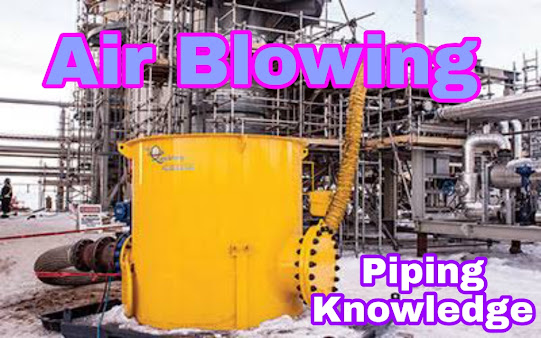Air Blowing in Piping Systems.
Air blowing is an industrial plant service that uses dry oil-free compressed air to clean piping of debris and contaminants.
INDEX:-
1. What is Air Blowing?
2. Cleaning Factor Ratio (CFR)of Air Blowing?
3. Feature of Air Blowing?
4. Methodology or Air Blowing?
5. Application & Problem of air Blowing.
6. Procedure of Air Blowing?
1. What is Air Blowing?
Air blowing is an industrial plant service that uses dry oil-free compressed air to clean piping of debris and contaminants.
It will remove construction debris, liquids, and semi adherent material, and safely transport the removed items out of the system.
This method allows for quick cleaning of piping systems without the need for disposal of large volumes of liquid cleaning solutions.
Air blowing is an industrial plant service that uses dry oil-free compressed air to clean piping of debris and contaminants. It will remove construction debris, liquids, and semi adherent material, and safely transport the removed items out of the system.
2. Cleaning Factor Ratio (CFR)of Air Blowing?
Cleaning Force Ratio (CFR) or Cleaning Factor (CF) is an industry-accepted factor that quantifies the ratio of required dynamic pressure for cleaning to maximum dynamic pressure experienced during system operation.
There are three modes of air blowing processes as explained below.
- Decompression (or) standard rupture blow
- Pulse (or) vessel rupture blow
- Continuous blow.
Cleaning Force Ratio
3. Feature of Air Blowing?
- Air blowing is one of cheapest method that move through large piping systems to remove dust, sand, debris.
- Air blowing is performed as per procedures and method statement.
- It eliminates or reduce debris in dirty pipes and also reduce contamination to give higher purity product.
- It also minimizes the damages to rotating equipment, filters, strainers, valve seat etc.
- Air blows are pressurized air in larger volumes and cannot remove tightly adherent rust or scales, dense larger degrees, paint, oil grease or varnish.
- Since air is being the lighter and abundantly available, the air blowing is connected at the entry point with large headers of pipe diameter and exits to the smaller diameter which is does not exceed 50% of larger daimeter pipe.
4. Methodology of Air Blowing?
During cleaning operation, the air velocity shall be as
follows.
- For gas process lines, the velocity shall be between 60 m/s and the velocity obtained at 1.3 times the max. process flow rate. The minimum velocity shall be 30 m/s.
- For liquid process lines, the velocity between 30 m/s to 60 m/s shall be used. If the quick decompression method is used, the pressure in the network is raised upto 6 bar.
5. Application & Problem of air Blowing.
- Air blowing is an industrial plant service that uses dry oil-free compressed air to clean piping of debris and contaminants.
- It will remove construction debris, liquids, and semi adherent material, and safely transport the removed items out of the system.
Problems of Air Blowing
- If quick decompression method is used, large volumes of air are required and it may take significant time to raise the pressure in the network.
- Air blowing is Hazardous operation. Very high forces are generated at the outlet. Therefore, specific safety procedures must be adhered to close by working area.
- Air quality, for instrument air, oil free air and/or dry air might be needed.
6. Procedure of Air Blowing?
- Systems to be cleaned are identified on the P&IDs and cleaning paths are marked. Injection points, exits points, valve positions, and equipment to be removed are detailed on the drawings.
- Cleaning force ratios, air pressures, and cleaning velocities are calculated for each of the air blows.
- Connection point details are recorded, and a bill of materials of temporary adaptors and equipment is created.
- The air blowing equipment including air compressors, air dryers, silencers, hoses, and temporary connection fittings is shipped to site.
- In the field the RIG Supervisor will walk down the system to be air blown following the procedure prepared by the engineer. Connection points, items to be removed, and access to the piping will be noted.
- The RIG crew will verify that the piping system is isolated. The temporary air blowing equipment will then be connected to the system.
- A safety briefing will be held and workers in the area will be notified that air blowing activities are about to start.
- The RIG crew will then pressurize the piping systems and release the air at the exit point. Contamination levels will be noted and the relevant parties (RIG, client, owner) will witness the cleaning.
- If targets are required, they will be inserted into the exit piping via a target inserter.
- Once the system is accepted as clean the temporary equipment will be removed from the piping and the system will be reinstated to await startup.
Thanks for visiting my blog.
Afzal.





Comments
Post a Comment